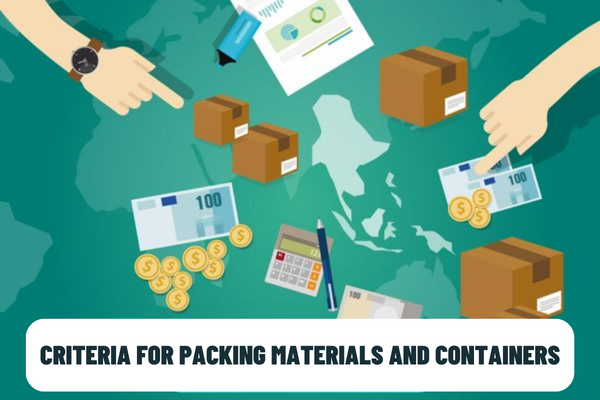What are the criteria for packing materials and containers of the rules of origin under the ASEAN-Japan Comprehensive Economic Partnership Agreement in Vietnam?
- What are the criteria for packing materials and containers of the rules of origin under the ASEAN-Japan Comprehensive Economic Partnership Agreement in Vietnam?
- What are the criteria for accessories, spare parts, tools and instructional or other information materials of the rules of origin under the ASEAN-Japan Comprehensive Economic Partnership Agreement in Vietnam?
- What are the criteria for indirect materials of the rules of origin under the ASEAN-Japan Comprehensive Economic Partnership Agreement in Vietnam?
- What is the direct consignment of the rules of origin under the ASEAN - Japan Comprehensive Economic Partnership Agreement in Vietnam?
What are the criteria for packing materials and containers of the rules of origin under the ASEAN-Japan Comprehensive Economic Partnership Agreement in Vietnam?
In Article 13 of Circular No. 37/2022/TT-BCT, the criteria for packing materials and containers of the rules of origin under the ASEAN-Japan Comprehensive Economic Partnership Agreement are as follows:
- Packing materials and containers for transportation and shipment of a good shall not be taken into account in determining the origin of any good.
- Packing materials and containers in which a good is packaged for retail sale, when classified together with the good, shall not be taken into account in determining whether all of the non-originating materials used in the production of the good have met the applicable change in tariff classification-based rule of origin for the good.
- If a good is subject to a regional value content-based rule of origin, the value of the packing materials and containers in which the good is packaged for retail sale shall be taken into account as originating or non-originating materials, as the case may be, in calculating the regional value content of the good.

What are the criteria for packing materials and containers of the rules of origin under the ASEAN-Japan Comprehensive Economic Partnership Agreement in Vietnam? (Image from the Internet)
What are the criteria for accessories, spare parts, tools and instructional or other information materials of the rules of origin under the ASEAN-Japan Comprehensive Economic Partnership Agreement in Vietnam?
In Article 14 of Circular No. 37/2022/TT-BCT, the criteria for accessories, spare parts, tools and instructional or other information materials of the rules of origin under the ASEAN-Japan Comprehensive Economic Partnership Agreement are as follows:
- If a good is subject to the requirements of change in tariff classification or specific manufacturing or processing operation, the origin of accessories, spare parts, tools and instructional or other information materials presented with the good shall not be taken into account in determining whether the good qualifies as an originating good, provided that:
+ the accessories, spare parts, tools and instructional or other information materials are not invoiced separately from the good; and
+ the quantities and value of the accessories, spare parts, tools and instructional or other information materials are customary for the good.
- If a good is subject to a regional value content-based rule of origin, the value of the accessories, spare parts, tools and instructional or other information materials shall be taken into account as the value of the originating or non-originating materials, as the case may be, in calculating the regional value content of the originating goods.
What are the criteria for indirect materials of the rules of origin under the ASEAN-Japan Comprehensive Economic Partnership Agreement in Vietnam?
According to Article 15 of Circular No. 37/2022/TT-BCT, the criteria for indirect materials of the rules of origin under the ASEAN-Japan Comprehensive Economic Partnership Agreement are as follows:
- Indirect materials shall be treated as originating materials regardless of where they are produced.
- The term “indirect materials” means goods used in the production, testing, or inspection of a good but not physically incorporated into the good, or goods used in the maintenance of buildings or the operation of equipment associated with the production of a good, including:
+ Fuel and energy.
+ Tools, dies, and moulds.
+ Spare parts and materials used in the maintenance of equipment and buildings.
+ Lubricants, greases, compounding materials and other materials used in production or used to operate equipment and buildings.
+ Gloves, glasses, footwear, clothing, and safety equipment and supplies.
+ Equipment, devices and supplies used for testing or inspecting the goods.
+ Catalysts and solvents.
+ Any other goods that are not incorporated into the good but whose use in the production of the good can reasonably be demonstrated to be a part of that production.
What is the direct consignment of the rules of origin under the ASEAN - Japan Comprehensive Economic Partnership Agreement in Vietnam?
In Article 12 of Circular No. 37/2022/TT-BCT, the criteria for the direct consignment of the rules of origin under the ASEAN-Japan Comprehensive Economic Partnership Agreement are as follows:
- Preferential tariff treatment shall be accorded to an originating good satisfying the requirements of this Circular and which is consigned directly from the exporting Party to the importing Party.
- The following shall be considered as consigned directly from the exporting Party to the importing Party:
+ a good transported directly from the exporting Party to the importing Party; or
+ a good transported through one or more Parties, other than the exporting Party and the importing Party, or through a non-Party, provided that the good does not undergo operations other than transit or temporary storage in warehouses, unloading, reloading, and any other operation to preserve it in good condition.
Circular No. 37/2022/TT-BCT takes effect from March 1, 2023.
LawNet